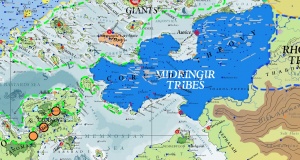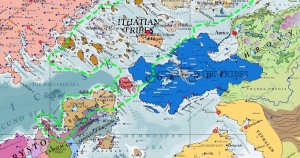Difference between revisions of "Midretassene Empire"
Trismegistus (talk | contribs) |
Trismegistus (talk | contribs) m |
||
| Line 13: | Line 13: | ||
{{Main|Midretassene Necromancy}} | {{Main|Midretassene Necromancy}} | ||
Midretassene necromantic practices did not originate from ancient [[Gwenyan]] customs, but were borrowed from [[Pytharnia]], either from the [[Moigthe]] or the [[Tuadbe]] and scholars generally believe that the ancient [[Neptultchi]] were the earliest source. Unlike the Yophentheans whose Arathracian religion was thoroughly intolerant of necromancy, Midretassene authorities often looked the other way or even enlisted the aid of necromancers in their wars of conquest. Midretassene necromancy achieved a high degree of professional excellence. | Midretassene necromantic practices did not originate from ancient [[Gwenyan]] customs, but were borrowed from [[Pytharnia]], either from the [[Moigthe]] or the [[Tuadbe]] and scholars generally believe that the ancient [[Neptultchi]] were the earliest source. Unlike the Yophentheans whose Arathracian religion was thoroughly intolerant of necromancy, Midretassene authorities often looked the other way or even enlisted the aid of necromancers in their wars of conquest. Midretassene necromancy achieved a high degree of professional excellence. | ||
| + | |||
| + | =Chronology of Midretasso= | ||
| + | {{Main|Chronology of Midretasso}} | ||
| + | *A chieftains, petty kings, & warlords | ||
| + | *B overking, league, league city of Diskor | ||
| + | *C merchant republic, Azabria | ||
| + | *D military republic, | ||
| + | *E Yophenthean Conquest | ||
| + | *F Heritage Civilization of Midretasso in Tassan, Dúrandworese, and Lucacian (Jecubian) Languages | ||
| + | |||
=History of Midretasso= | =History of Midretasso= | ||
Revision as of 11:51, 26 January 2025
The Midretasssene Empire developed from the Kingdom of Midretasso and remained essentially a monarchy through the imperial period, lasting through the first half of the first millennium after Salmakhamer until it was conquered by the Yophenthean Empire in the sixth century AI. Midretassene heritage remains strongest in the Tassan Highlands of eastern Corundy. Midretasso borrowed and re-transmitted components of late Kalaman Civilization throughout its empire, including astronomy, metaphysics, engineering, medicine, and traditions about very deep antiquity. Salmakhamer, the prophet of the renaissance of Isxinthion Worship was a Midrinksi Aristocratic Priest whose mission established the first year of the Common Calendar. Midretasso was known for its dark religious superstitions, strong military organization, necromancers, gladiatorial combats, and pretense of the rule of law.
Government
In the second century, a Meddix was elected by the assembled nobles of the various Midrinksi tribe to preside over their League. He was not permitted to be one of the existing chieftains or their heirs. The League system eventually broke down through conflicts that ultimately saw Uturnus established around the beginning of the third century as the Over-King. The office of Meddix was retained. The tribal chieftains and Jathya-Dhumi princes became subject to the Over-King, while retaining some degree of autonomy in their internal affairs.
Midretassene Religion
Midretassene Gods are cultural adaptations of the Isxinthion Gods, like most Gwenyan Cultures, with additional divinities from the steppes and ancient Kalama. Devil-worship, whether of true devils or devil-like divinities, was practiced in households and businesses as these entities were thought to protect one's fortunes and needed to be bribed with offerings to avert their mischief. Cetibrymio became the national shrine and pilgrimage site of the Over-Kingdom.
Necromancy
Midretassene necromantic practices did not originate from ancient Gwenyan customs, but were borrowed from Pytharnia, either from the Moigthe or the Tuadbe and scholars generally believe that the ancient Neptultchi were the earliest source. Unlike the Yophentheans whose Arathracian religion was thoroughly intolerant of necromancy, Midretassene authorities often looked the other way or even enlisted the aid of necromancers in their wars of conquest. Midretassene necromancy achieved a high degree of professional excellence.
Chronology of Midretasso
- A chieftains, petty kings, & warlords
- B overking, league, league city of Diskor
- C merchant republic, Azabria
- D military republic,
- E Yophenthean Conquest
- F Heritage Civilization of Midretasso in Tassan, Dúrandworese, and Lucacian (Jecubian) Languages
History of Midretasso
Twelfth through First Centuries Before Salmakhamer
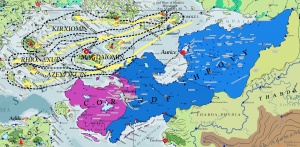
Jathya-Dhumi Civilization, already weak from millennia of internecine conflicts and previous barbarian migrations from the east, collapses around the twelfth century before Salmakhamer, leaving a patchwork of princes, dukes, warlords, and independent city-states. Midrinksi Tribes under various chieftains, without any central ruler, migrate in waves from western Asdauria into the lands of Vindalia, formerly held by the once vast Kalaman Empire in millennia past. The vestiges of the Zhalayara Khuswa Dynasty (1163 AS to 1117 AS), the last of the Jatha-Nebir Kingdom, gradually succumb to the nomadic tribesmen.
Jathya-Dhumi nobles and Midrinksi nobles largely refrain from intermarriage.
First Century: 1 to 99
Around the time of Salmakhamer, the Midrinksi Tribes were a loose confederation that had conquered all of the core lands of ancient Kalama and what is now Lucacia. Midrinksi Tribes employed horses and other beasts of burden and were still semi-nomadic in the first century. Outside of Vindalia, the Ithatian Islands, Maturn, Deliops, Zander, Desthor, and the Thykomian Isles are ruled by various governments. In the Ambrinquan Peninsula, Ebinóë is under the rule of two neighboring kingdoms, Gorcorumb rules the Ephysgæee Mountains, Kesheph is united under a single kingdom, and Narshad is united under its own sea-kingdom. Western Jakubya (Lucacia) is held by the Midrinksi Tribes, but the remaining lands are convulsed with migrations from Asdauria. Elsewhere, the Shadevan Delta is ruled by stone giants (Kumeimidir) and Moigthe Tribes. Southern Pytharnia is a patchwork of Moigthe Tribes, Tuadbe remnants, Kemerite Giant remnants, and lone Neptultchi chieftains.
Cetibrymio, originally a Jathya-Dhumi city, re-colonized by Pallathantic and Ithatian migrations, is now established as the primary pilgrimage site for Midrinksi chieftains and nobles. Some marriages between Jathya-Dhumi nobles and Midrinksi nobles occur.
Notable Persons: The prophet Salmakhamer, b ca 38 AS, Uthurnia; d ca 45 AI, ? Elántuventh
Second Century: 100 to 199
The transition from Midrinksi Tribes to Midretasso is under way. The tribes are largely settled, having adopted many of the customs of the Jathya-Dhumi and Kalaman civilization. They still lack any sort of overlord, but visit common places of pilgrimage, recognize common gods and religious practices, and recite similar legends about their migration into Vindalia.
The Midrinksi Chieftains attempt to bring their tribes under a single ruler in various conflicts and treaties. The short-lived Midretassene League is formed under the governance of a Meddix, a noble, but not an existing chieftain, elected by the nobles of the various tribes assembled in Cetibrymio. Disagreements about rule and precedence bring the tribes into conflict in a series of battles that ultimately see the establishment of the Over-Kingdom in the third century.
Vimalia continues to be ruled by native Jathya-Dhumi princes, subject to Midrinksi Chieftains, and later the Midretassene League. Many of these dynasties inter-marry with Midrinksi nobles.
Third Century: 200 to 299
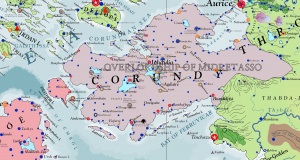
By the first part of the third century, the Midrinksi Tribes have been united by a series of wars and treaties underneath Uturnus, the first Over-King of Midretasso. Jathya-Dhumi Princes and Ithatian Colonists are forced to submit to his rule. By roughly the middle of the third century (ca. 240 AI), outside of Vindalia, Zeo has brought a vast dominion of peoples and tribes under his rule in the Ambrinquan Peninsula, Thrysto, Heruliconia, and Thyria. His empire does not survive his death, but swiftly succumbs to the rule of his generals and various local princes. On the isle of Erechóreb around 260 AI, the Yophentheans have brought the great island proper under the rule of the semi-mythical Arathraciot Dynasty, 268 to 383 AI. Southern Pytharnia is held by countless chieftains, druidic priests, and witch-kings.
Fourth Century: 300 to 399
In the fourth century, Midretasso's dominion spreads into most of Jakubya (Lucacia), through the Ithatian islands, and into the Shadevan Delta. Conflicts on the steppes with the Turgos Centaurs and the Rhovanites are resolved ultimately by military victory for Midretasso. Meanwhile, the Yophentheans have secured Nymentho, the Giant Isles, and, in southern Pytharnia, Rhafindwor, and much of Esphagonia. The future site of Aurice is occupied by fishing villages. Sky Tribes from the Jaggudorns have migrated into the skies above Midretassene Dominions, including the Shehabil from the southern Jaggudorns to the mountain peaks of the Shadevan Delta and the Solmagali over the Memnosian Sea. The Tritigosto Campaigns brought about the inclusion of lands south of the Corundian Peninsula that later became Ferruvicar.
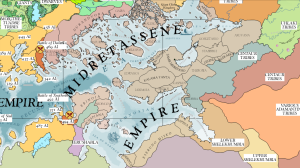
Fifth Century: 400 to 499
The Midretassene Empire achieves its greatest extent around the late fifth century to early sixth century. The island of Atizamnos (Mirrhaimo) was conquered in 408 AI. The Pytharnian holdings now include Dúrandwor, Agogia, and most of the Shadevan Delta. The Stone Giants (Kumeimidir) of southern Shadevan Delta and the common giants of western Ambrulia are made into two separate client kingdoms under the Midretassene Over-King. The Battle of Curchása, 415 AI, brought an end to the conflict between Midretassene Dúrandwor and the Moigthe tribes of the Pytharnian Highlands under Girrhain Witch-King. The Yophentheans expand in southern Pytharnia, conquering the rich Durrhaunve, bringing Midretasso into conflict (see Battle of Danallo, 469 AI). In the greatest conflict of the fifth century, Midretasso attempts to conquer the Yophenthean Kingdom in the Thursar War, 473 to 485, ending in defeat, but their dominions are secured for the time being by treaty. By the end of the Fifth century, war breaks out again between Yophenthea and Midretasso, provoked by the Battle of Xyathoth, 492 AI, regarding trade access. Yophenthean Merchant Marines in the Bay of Ambrinqua are defeated, starting the second great conflict between the two empires, known as the Zelukian War, 492 AI to 513 AI.
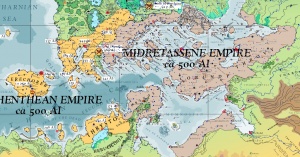
The provinces of the Midretassene Empire at this time were: Zamir Midretasso, Talthassa, Edraska, Desthor, Kalama Yanta, Iaximoia, Brixos, Kasphia, Kasphidirra, Therobia, Lelenia, Zelekarka, Stabirrui, Gosketasso, Axuvana, Arserrui, Durandvora, Durandvora Kulabsa, Gaira, Maleska, Galiria, Maturnos, Azantirga, Deliopos, Zandros, Thukomia, Ebinoia, Ardinoia, Cospiana, Narsadrui; Client Kingdom(s): Zehadrui
Sixth Century: 500 to 599
Treaties fail and war arises again between Midretasso and Yophenthea as a result of the Battle of Xyathoth, 492. This second great conflict known as the Zelukian War (492 AI to 513 AI) ends in disastrous defeat for the Midretassene Empire in 513 AI with the Battle of Siul. The conflict is called 'Zelukian' after the Midretassene name for mercenary necromancers who helped fill naval vessels with undead rowers and marines for the Midretassene Navy. Despite the advantage of disposable marines, Yophenthean sun-priests' powers defeat the undead sailors, culminating in the Battle of Siul where their Merfolk allies help them destroy the Midretassene Armada sent to subject Erechóreb. The subsequent series of conflicts, the Yophenthean Conquest of Midretasso, 515 to 553, between the two empires constitute the third war and see the successive subjection of Midretasso's core territory to the priest-kings of Yophenthea. During this time, the Midretassene ruling class was torn with internal conflict and disunity.
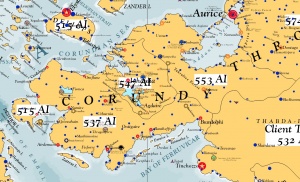
Heritage and Legacy
Eastern Corundy "Zamiria" and western Jakubya (Lucacia) are today inhabited by numerous persons of Midretassene heritage. The Tassan Language of Zamiria is descended from ancient Midretassene Language. The prophet-priest, Salmakhamer, remains an important figure in ancient history for his re-establishment of the Isxinthion Gods and basis for the years of the Common Calendar.
Chronology of Midretasso
The chronology of the Midretassene Empire begins around the year 200 AI and ends in the sixth century with the Yophenthean Conquest of Midretasso. Before 200 AI, Midretassene Culture begins in the eighth century AS with the migration of the Midrinksi tribes into the Kalaman Peninsula (Corundian Peninsula).
See Also
- List of the Over-Kings of Midretasso
- Midretassene-Yophenthean Wars
- Midretassene Language
- Midretasso
- Midrinksi Tribes
- Necromancy in Ancient Midretasso
| This article is a stub. It requires further development by the creator. |
